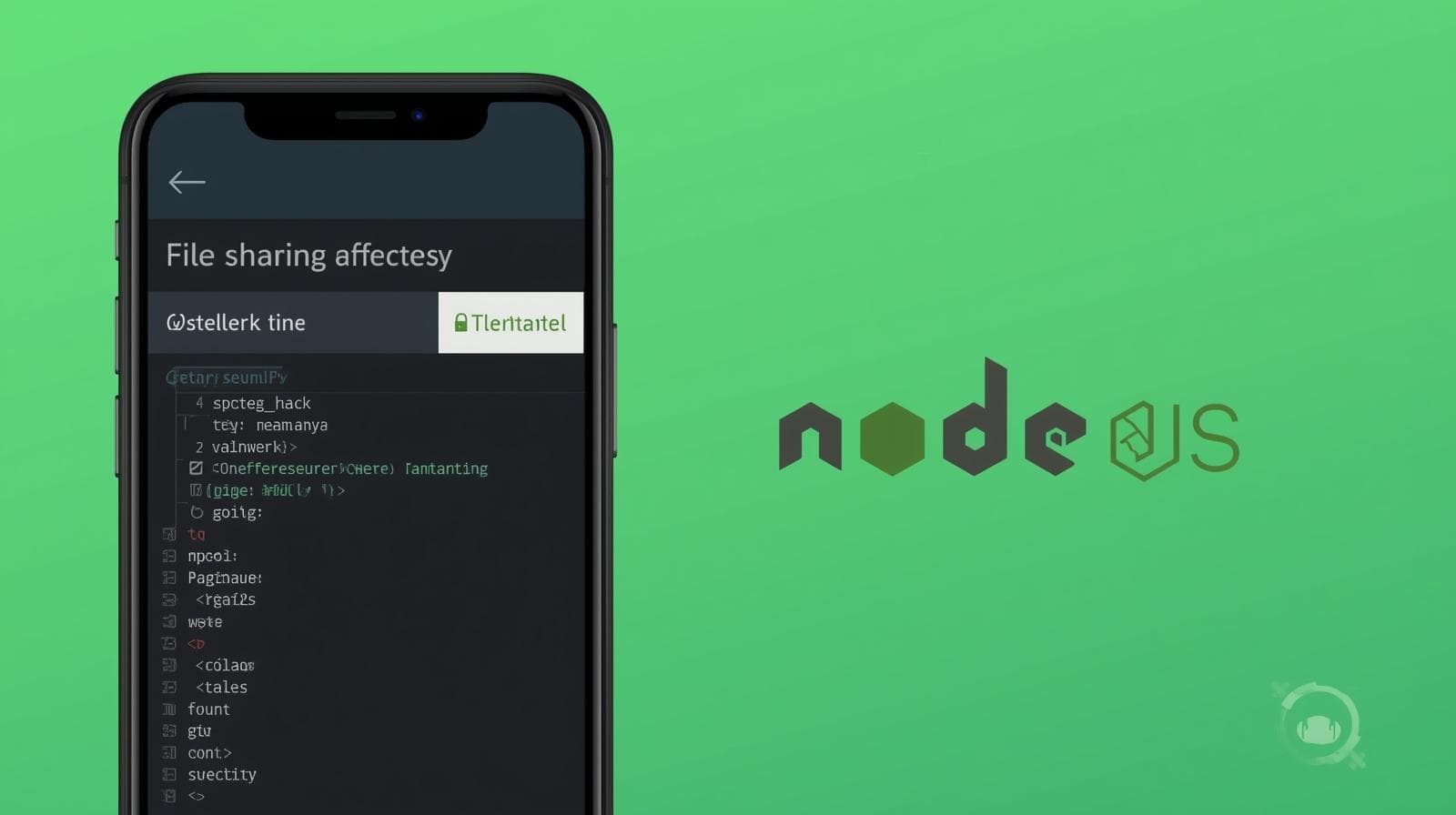Node.js Security: A Developer's Ultimate Guide to Best Practices (2025)

Fortify your Node.js applications! This in-depth guide covers essential security practices, from dependency management to authentication & API security.

Node.js Security: A Developer's Ultimate Guide to Best Practices (2025)
Node.js Security: The Developer's Ultimate Guide to Building Fortified Applications
Picture this: you’ve spent months crafting a brilliant Node.js application. It’s fast, it’s scalable, and the features are exactly what your users need. You launch it, and for a few weeks, everything is perfect. Then, one morning, you wake up to a nightmare. Your database has been wiped, user data is being sold on the dark web, and your application is a smoking crater of its former self.
This isn't just a scary story; it's a daily reality for companies that treat security as an afterthought. In the digital world, your application's security is its foundation. A single vulnerability can compromise everything you've built.
The good news? As a Node.js developer, you have a powerful toolkit at your disposal to prevent these disasters. Security isn't about magic bullets; it's about consistent, intelligent practices woven into the fabric of your development process.
In this comprehensive guide, we’re going to move beyond the basics. We'll dive deep into the why and the how of Node.js security, equipping you with the knowledge to build applications that are not just functional, but truly fortified.
Why Should Node.js Developers Care Deeply About Security?
Node.js is ubiquitous. It powers everything from lightweight APIs to enterprise-level backend systems. This popularity, however, makes it a prime target for attackers. JavaScript's dynamic nature and the heavy reliance on open-source packages (the famous node_modules folder) introduce a unique set of security challenges.
Ignoring these challenges isn't an option. The consequences are severe:
Data Breaches: Leaking sensitive user information (PII).
Financial Loss: Theft, fraud, or massive fines from regulations like GDPR.
Reputational Damage: Losing the trust of your users is often the most devastating blow.
Service Disruption: Downtime due to DDoS attacks or ransomware.
Security isn't a "feature" you add at the end. It's a core principle of professional software development. To learn professional software development courses such as Python Programming, Full Stack Development, and MERN Stack, which deeply ingrains these principles, visit and enroll today at codercrafter.in.
The Pillars of Node.js Security: A Deep Dive into Best Practices
Let's break down the most critical security practices into actionable pillars.
Pillar 1: Taming the Dependency Jungle
If you've ever run npm install, you know your project can pull in hundreds, even thousands, of external packages. This is Node.js's greatest strength and its most significant weakness.
The Problem: Vulnerabilities in Your node_modules
A single vulnerable package can be the backdoor an attacker needs. Remember the log4shell vulnerability? It sent the entire internet into a frenzy, demonstrating how a single dependency can cause global chaos.
Best Practices:
Audit, Audit, Audit: Use
npm auditregularly. This built-in command scans your dependency tree and reports known vulnerabilities.Pro Tip: Run
npm audit --audit-level highto fail your CI/CD pipeline builds if high or critical vulnerabilities are found. Automate this!
Automate Vulnerability Scanning: Integrate tools like Snyk or GitHub's Dependabot directly into your repositories. They automatically create pull requests to update vulnerable dependencies, often before you even know a vulnerability exists.
Lock Your Dependencies: The
package-lock.jsonfile is not just for consistency; it's for security. It locks every package to a specific, verified version, preventing a malicious actor from pushing a slightly altered version that your build might accidentally pick up.Use
npm cifor Production Builds: Unlikenpm install, which can update the lockfile,npm ci(clean install) strictly installs from thepackage-lock.json. This guarantees that what you tested is exactly what goes to production.
Pillar 2: Fortifying Your Web Application Armor
Your application's HTTP layer is the first point of contact for users and attackers alike. Hardening it is non-negotiable.
A. Helmet.js: Your First Line of Defense
Helmet.js is a collection of middleware functions that set various HTTP headers to secure your Express app. It's not a silver bullet, but it closes many common attack vectors with just a few lines of code.
javascript
const express = require('express');
const helmet = require('helmet');
const app = express();
// Use Helmet!
app.use(helmet());
// ... rest of your appWhat does Helmet do?
helmet.contentSecurityPolicy: Mitigates Cross-Site Scripting (XSS) by whitelisting sources of trusted content.helmet.hsts: Forces browsers to use HTTPS.hidePoweredBy: Removes theX-Powered-By: Expressheader to avoid revealing your tech stack.noSniff: Prevents browsers from MIME-sniffing a response away from the declared content-type, which can stop certain types of file upload attacks.
B. Input Validation: Trust No One
The golden rule of security: Never, ever trust user input. Every piece of data coming from a client—whether from a form, URL parameter, or API request—must be validated.
The Wrong Way:
javascript
// DANGER! This is highly vulnerable.
app.post('/user', (req, res) => {
const userId = req.body.id;
// Directly using input in a query? Big mistake.
db.query(`SELECT * FROM users WHERE id = ${userId}`, (err, result) => {
// ...
});
});This is a classic SQL Injection vulnerability. An attacker could send id as '1; DROP TABLE users--' and potentially wipe your database.
The Right Way: Use a Validation Library.
Use Joi or Yup for validating request bodies.
javascript
const Joi = require('joi');
const userSchema = Joi.object({
id: Joi.number().integer().min(1).required(),
email: Joi.string().email().required(),
password: Joi.string().min(8).pattern(new RegExp('^(?=.*[a-z])(?=.*[A-Z])(?=.*[0-9])'))
});
app.post('/user', (req, res) => {
const { error, value } = userSchema.validate(req.body);
if (error) {
return res.status(400).send(error.details[0].message);
}
// Proceed with the validated 'value' object...
});For SQL, always use parameterized queries with an ORM like Sequelize or a query builder like Knex.js, which handle escaping for you.
C. SQL/NoSQL Injection: Don't Let Them In
SQL Injection: As shown above, using string concatenation to build queries is a cardinal sin. Use parameterized queries.
NoSQL Injection: Yes, even MongoDB can be injected! An attacker could send a MongoDB operator like
{ "$gt": "" }in a password field to bypass authentication.
Vulnerable Code:
javascript
app.post('/login', (req, res) => {
User.findOne({
username: req.body.username,
password: req.body.password // An attacker could send { "$ne": "invalid" }
}, (err, user) => {
if (user) {
// Unauthorized access granted!
}
});
});Solution: Sanitize input. Use a library like mongo-sanitize or, better yet, always cast your values to the expected type.
javascript
const sanitize = require('mongo-sanitize');
app.post('/login', (req, res) => {
const username = sanitize(req.body.username);
const password = sanitize(req.body.password);
// Now use the sanitized values...
});Pillar 3: Mastering Authentication and Session Management
Getting authentication wrong is one of the fastest ways to lose control of your application.
Never Store Plain-Text Passwords: Always hash passwords using a strong, one-way hashing algorithm like bcrypt, scrypt, or Argon2.
javascript
const bcrypt = require('bcrypt'); const saltRounds = 12; // The higher, the more secure (but slower) // Hashing a password const hashPassword = async (plainTextPassword) => { return await bcrypt.hash(plainTextPassword, saltRounds); }; // Checking a password const isValid = await bcrypt.compare(plainTextPassword, storedHash);Strengthen Your Session Management:
Use secure, random strings for session IDs (Express-Session does this by default).
Always set the
securecookie flag in production to ensure cookies are only sent over HTTPS.Set
httpOnlyon authentication cookies to prevent access from client-side JavaScript, mitigating XSS attacks.Implement sensible session expiration.
Embrace JWT, But Do It Safely: JWTs are stateless and great for APIs.
Sign them with a strong secret (like RS256) and never put sensitive data in the payload (it's base64 encoded, not encrypted).
Store them securely on the client. While local storage is tempting, it's vulnerable to XSS. Using
httpOnlycookies is often more secure for web apps.Implement a token blacklist for logout, even though JWTs are stateless.
Pillar 4: Environment Configuration & Secrets Management
How many times have you seen an API key hardcoded in a config.js file? This is a massive risk.
Use Environment Variables: Store configuration that changes between deployments (like database URIs, API keys, and secrets) in environment variables. The
dotenvpackage is perfect for this.bash
# .env file DB_URI=mongodb://localhost:27017/myapp JWT_SECRET=your-super-secret-long-random-string API_KEY=your-api-keyjavascript
// In your app require('dotenv').config(); const dbUri = process.env.DB_URI; const jwtSecret = process.env.JWT_SECRET;Never Commit
.env: Add.envto your.gitignorefile immediately!Use Secret Management Services: For production, use services like AWS Secrets Manager, HashiCorp Vault, or Azure Key Vault to manage and rotate secrets securely.
Pillar 5: Handling Errors Gracefully (Without Leaking Info)
Error messages are a goldmine for attackers.
The Bad Way:
javascript
app.get('/user/:id', (req, res) => {
User.findById(req.params.id, (err, user) => {
if (err) {
res.status(500).send(`Error: ${err.message}`); // Leaks stack trace!
} else {
res.send(user);
}
});
});This could leak stack traces, database schemas, or file paths.
The Good Way:
javascript
app.get('/user/:id', (req, res) => {
User.findById(req.params.id, (err, user) => {
if (err) {
// Log the full error for internal debugging
console.error(err);
// Send a generic message to the client
res.status(500).send('An internal server error occurred.');
} else {
res.send(user);
}
});
});Pillar 6: Running with Least Privilege
Your Node.js process shouldn't run as root. Create a dedicated user for your application with the minimum permissions required to run. This limits the damage if your application is compromised.
dockerfile
# Example in a Dockerfile
FROM node:18-alpine
RUN addgroup -g 1001 -S nodejs
RUN adduser -S nextjs -u 1001
USER nextjs
# ... rest of your DockerfilePillar 7: Rate Limiting and Brute-Force Protection
Protect your login endpoints and API from being hammered by automated scripts.
Using express-rate-limit:
javascript
const rateLimit = require('express-rate-limit');
const limiter = rateLimit({
windowMs: 15 * 60 * 1000, // 15 minutes
max: 5, // Limit each IP to 5 login attempts per `windowMs`
message: 'Too many login attempts, please try again later.',
standardHeaders: true, // Return rate limit info in the `RateLimit-*` headers
legacyHeaders: false, // Disable the `X-RateLimit-*` headers
});
app.post('/login', limiter, (req, res) => {
// ... login logic
});Real-World Use Case: Securing a Simple Express API
Let's put it all together in a mini-application.
javascript
const express = require('express');
const helmet = require('helmet');
const rateLimit = require('express-rate-limit');
const Joi = require('joi');
const bcrypt = require('bcrypt');
require('dotenv').config();
const app = express();
// 1. Middleware
app.use(helmet()); // Security headers
app.use(express.json()); // Parse JSON bodies
app.use(rateLimit({ windowMs: 15 * 60 * 1000, max: 100 })); // General rate limiting
// 2. Input Validation Schema
const userSchema = Joi.object({
username: Joi.string().alphanum().min(3).max(30).required(),
email: Joi.string().email().required(),
password: Joi.string().min(8).required(),
});
// 3. A "Secure" Route
app.post('/api/register', async (req, res) => {
// Validate input
const { error, value } = userSchema.validate(req.body);
if (error) return res.status(400).send(error.details[0].message);
try {
// Hash password
const hashedPassword = await bcrypt.hash(value.password, 12);
// ... logic to save user (with hashedPassword) to the database
// const user = await User.create({ ...value, password: hashedPassword });
res.status(201).json({ message: 'User created successfully!' });
} catch (err) {
console.error(err); // Log for us
res.status(500).send('Error creating user.'); // Generic for client
}
});
const PORT = process.env.PORT || 3000;
app.listen(PORT, () => {
console.log(`Server running on port ${PORT}`);
});This snippet demonstrates helmet, rate limiting, Joi validation, bcrypt hashing, and safe error handling—a solid foundation.
FAQs: Your Node.js Security Questions, Answered
Q1: Is npm audit fix safe to run blindly?
A: Generally, yes for patch and minor versions. However, for major version updates, it can introduce breaking changes. It's best to run npm audit fix --dry-run first to see what it will do, and then test thoroughly after applying the fix.
Q2: How often should I update my dependencies?
A: Regularly. A good practice is to set up a weekly task to review and update dependencies, aided by tools like Dependabot. Don't let them stagnate for months.
Q3: What's the single most important security practice?
A: It's impossible to pick one, as security is a chain—it's only as strong as its weakest link. However, if forced to choose, input validation and sanitization would be a top contender, as it directly blocks a huge class of common attacks.
Q4: Can I rely solely on a Web Application Firewall (WAF)?
A: Absolutely not. A WAF (like AWS WAF or Cloudflare) is a fantastic security layer. It can help block known bad traffic and DDoS attacks. But it's not a substitute for writing secure code. Think of it as a moat around your castle, but you still need strong walls (your code) inside.
Conclusion: Building a Security-First Mindset
Securing your Node.js applications isn't a one-time task you check off a list. It's an ongoing process, a mindset that must be integrated into every stage of your development lifecycle—from writing the first line of code to deployment and monitoring.
By internalizing the practices we've discussed—managing dependencies, hardening your HTTP layer, validating all input, securing authentication, protecting your secrets, and handling errors wisely—you transform from a developer who writes code to a professional who builds robust, trustworthy systems.
The journey to becoming a security-conscious developer is challenging but immensely rewarding. It's the mark of a true craftsman. If you're ready to take your skills to the next level and master not just security, but the entire landscape of modern web development, we are here to guide you. To learn professional software development courses such as Python Programming, Full Stack Development, and MERN Stack, visit and enroll today at codercrafter.in. Let's build the future, securely.









